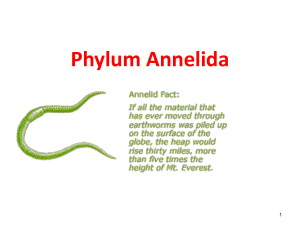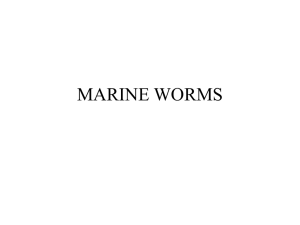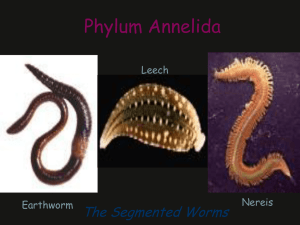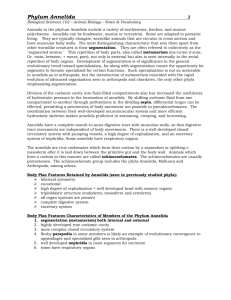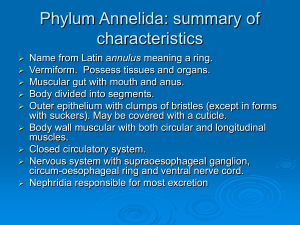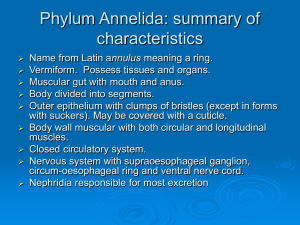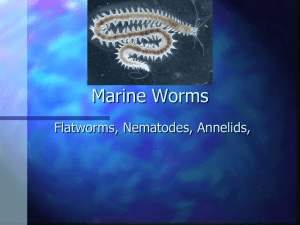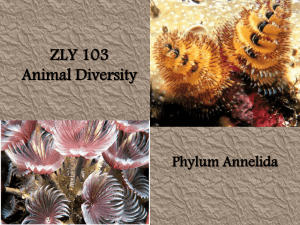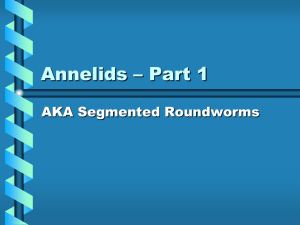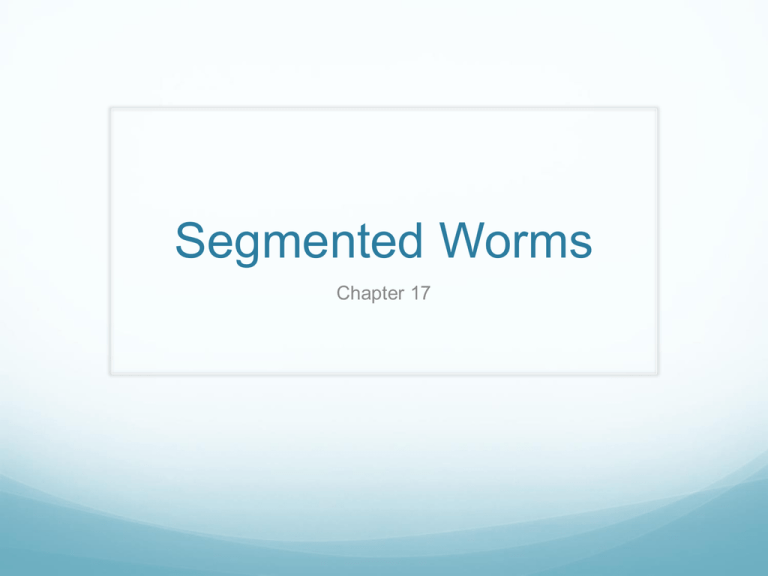
Segmented Worms
Chapter 17
Annelids and Allied Taxa
Phylum Annelida
Clade
Pleistoannelida
Errantia
Sedentaria
Phylum Sipuncula
Annelids and Allied Taxa
Members of Phylum Sipuncula are benthic marine
animals with unsegmented bodies.
Molecular sequence data place echiurans within
phylum Annelida.
Sipunculans - Sister taxon to Annelida.
Phylum Annelida
Annelids are
protostome coelomates
in superphylum
Lophotrochozoa.
Spiral, determinate
cleavage.
Nervous system more
centralized & circulatory
system more complex
than in previous phyla.
Phylum Annelida
Annelids are segmented worms.
They have bodies composed of a series of
fused rings.
Earthworms, leeches, clam worms.
Phylum Annelida
The evolutionary innovation shown by annelids is
segmentation (metamerism).
Segmentation evolved separately in annelids, arthropods,
and chordates.
The body is divided into a series of segments, each
having similar components of all major organ systems.
Built in fail-safe.
Allows for specialization.
Phylum Annelida
Many annelids have
chitinous bristles
called setae.
Help in locomotion
Anchor worm in
place
Deter predators
Phylum Annelida
Annelids can be found worldwide in marine,
freshwater, and terrestrial habitats.
Phylum Annelida – Body Plan
Prostomium –
anterior part
followed by
segmented body.
Pygidium – terminal
portion.
Phylum Annelida – Body Plan
Peritonia (layers of
mesodermal
epithelium) of
adjacent segments
meet to form septa.
Fluid-filled coelom
acts as a
hydrostatic
skeleton.
Phylogeny
Traditionally, annelids are divided among 3 classes:
Class Polychaeta
Class Oligochaeta
Class Hirudinida
Polychaeta is a paraphyletic class because ancestors
of the clitellates arose from within it.
Oligochaeta and Hirudinida form a monophyletic group
called Clitellata.
Characterized by reproductive structure called a clitellum.
Class Oligochaeta is a paraphyletic group because
ancestors of leeches arose from within it.
Clade Pleistoannelida
New
Classification:
Clade Errantia
Clade
Sedentaria
Errantia
Errant polychaetes
have some features
other annelids do not:
A well developed
head.
Paired appendages,
parapodia, that
function as gills and
aid in locomotion.
No clitellum.
Many setae
Errantia
Errant forms include
pelagic and benthic
types and are often
predators or
scavengers.
Reproduction
Gonads are temporary structures in polychaetes.
Sexes usually separate.
Fertilization is external.
Early larva is a trochophore.
Circulation and Respiration
Most have parapodia and gills for gaseous
exchange.
Others use the body surface.
Circulation varies.
In Nereis a dorsal vessel carries blood forward and a
ventral vessel carries blood posteriorly.
Blood flows across between these major vessels in
networks around the parapodia and intestine.
In some, septa are incomplete and coelomic fluid
serves circulatory function.
Many polychaetes have respiratory pigments Hemoglobin, chlorocruorin or hemerythrin.
Excretion
Excretory organs vary, from protonephridia to
metanephridia, and mixed forms.
One pair per metamere.
Inner end (nephrostome) opens into the
coelomic cavity.
Coelomic fluid enters the nephrostome.
Selective resorption occurs along the nephridial
duct.
Nervous System and Sense Organs
Double ventral nerve cord runs length of the
worm with ganglia in each metamere.
Sense organs include:
Eyes, nuchal organs and statocysts.
Eyes vary from simple eyespots to well-developed
image-resolving eyes similar to mollusc eyes.
Nuchal organs are ciliated sensory pits that are
probably chemoreceptive.
Some burrowing and tube-building polychaetes use
statocysts to orient their body.
Representative Errant
Polychaetes
Clam Worms: Nereis
Errant polychaetes
Live in mucus-lined burrows
near low tide level.
Come out of hiding places at
night to search for food.
Prostomium bears a pair of
palps sensitive to touch and
taste, a pair of short sensory
tentacles, and two small
dorsal eyes sensitive to light.
Peristomium has a ventral mouth, a pair of jaws, and
four pairs of sensory tentacles.
Representative Errant
Polychaetes
Scale worms
Flattened bodies
are covered with
broad scales.
Some are large, all
are carnivores and
some are
commensals in
burrows of other
organisms.
Representative Errant
Polychaetes
Fireworms
Have hollow, brittle
setae that contain
poisonous
secretions.
Feed on cnidarians.
Sedentaria
Sedentaria now
includes the
sedentary
polychaetes
(tubeworms,
siboglinids),
echiurans,
oligochaetes and
leeches.
Sedentaria
Sedentary forms
often have
elaborate
devices for
feeding and
respiration.
Filter or deposit
feeders.
Representative Sedentary
Polychaetes
Tubeworms
Tube-dwellers
May line their
burrows with mucus
Use cilia or mucus
to obtain food
Representative Sedentary
Polychaetes
Fanworms or
Featherduster
worms
Unfurl tentacular
crowns to feed.
Food moved from
radioles to mouth
by ciliary action.
Representative Sedentary
Polychaetes
Parchment Worms
Lives in a U-shaped
tube.
Modified segments
pump water through
tube.
Clade Siboglinidae
(Pogonophorans)
Formerly members of
phylum Pogonophora
(beardworms).
Discovered in 1900.
150 species described.
Most are small, less than
1 mm in diameter.
Giant beardworms that
live in deepwater
hydrothermal vents are 3
m long and 5 cm in
diameter.
Family Siboglinidae
(Pogonophorans)
Most live in mud on ocean floor at depths of 100 - 10,000m.
Sessile animals that secrete and live in long chitinous
tubes.
Tubes have general upright orientation in bottom
sediments.
Tubes are generally three or four times the length of the
animal.
http://www.youtube.com/watch?v=2FFnrW_SUdM
Family Siboglinidae
(Pogonophorans)
Long cylindrical body covered with cuticle.
Divided into a short anterior forepart, a long slender
trunk, and a small, segmented opisthosoma.
Tentacles are hollow extensions of the coelom and
bear minute pinnules.
Family Siboglinidae
(Pogonophorans)
No mouth or digestive tract.
Nutrients such as glucose and amino acids absorbed
from seawater through pinnules and microvilli of
tentacles.
Family Siboglinidae
(Pogonophorans)
Most energy derived from a mutualistic relationship
with chemoautrophic bacteria that oxidizes hydrogen
sulfide.
Trophosome, derived embryonically from midgut,
houses the bacteria.
Family Siboglinidae
(Pogonophorans)
Sexes are separate.
Research suggests that cleavage is unequal and
atypical.
Appears to be spiral.
Coelom formed by schizocoely.
Embryo
Worm-shaped and ciliated.
Poor swimmer.
Probably carried by water currents until it settles.
Osedax – bone eating worms
http://www.youtube.com/watch?v=URi8KccVkks
Family Echiuridae
Approximately 140
species of marine
worms that burrow into
mud or sand.
Live in empty snail
shells or sand-dollar
tests, or rocky crevices.
Found in all oceans.
Length varies from a
few millimeters to 40 or
50 cm.
Family Echiuridae – Form and
Function
Sausage-shaped.
Inextensible proboscis
anterior to the mouth.
Often called spoon
worms”.
Simple nervous system
with a ventral nerve
running length of the
body.
Ciliated groove on the
proboscis allows them to
gather detritus over the
mud while lying buried.
Muscular body wall is covered by a cuticle and
epidermis which may be smooth or covered by papillae.
Family Echiuridae
Large coelom.
Digestive tract long and coiled.
Most have a closed circulatory
system with colorless blood.
Hemoglobin found in certain
cells and in coelomic
corpuscles.
Respiration probably occurs in
hindgut which is continually
filled and emptied by cloacal
irrigation.
Family Echiuridae Reproduction
Sexes are separate.
Gonads produced by special regions in peritoneum in
each sex.
Fertilization usually external.
Early cleavage and trochophore stages similar to
annelids.
Clade Clitellata
Class Oligochaeta and Class Hirudinida
Form reproductive structure called a clitellum.
Ring of secretory cells found in a band around the body.
Permanent in oligochaetes but visible only during
reproductive season in leeches.
Members are derived annelids that lack parapodia.
Hermaphroditic (monoecious) animals that exhibit
direct development.
Young develop inside a cocoon secreted by the
clitellum, and emerge as small worms.
Oligochaeta
Class Oligochaeta includes earthworms and
many freshwater worms.
They possess setae, but not as much as
polychaetes.
Oligochaeta
Earthworms are the
most familiar
oligochaetes, found in
moist, rich soil.
They can burrow deep
underground and
remain dormant in a
slime chamber during
dry weather.
Setae help prevent
slipping while
burrowing.
Oligochaeta
Darwin wrote about earthworms in The Formation of
Vegetable Mould Through the Action of Worms.
He noted the beneficial activities of worms, aeration,
moving nutrients up from subsoil, adding nitrogenous
products, breakdown of organic matter in dead leaves
etc.
An earthworm can ingest its own weight in soil every 24
hours.
Oligochaeta - Reproduction
Earthworms are hermaphroditic – male and
female organs in the same animal.
When mating, two worms are held together by
mucus secreted by the clitellum.
Oligochaeta - Reproduction
After mating, a
cocoon forms
around the
clitellum, as it
passes forward it
gathers both
gametes, and
fertilization
occurs inside.
Oligochaeta - Reproduction
Development occurs
inside the cocoon
and young worms
hatch out.
Development is
direct, no larval
stage.
Oligochaeta - Feeding
Food is stored in a thin-walled crop.
Muscular gizzard grinds food into small
pieces.
Digestion and absorption occur in intestine.
Oligochaeta - Excretion
Each segment, except the
1st three and terminal one,
have a pair of metanephridia.
A ciliated funnel, the
nephrostome, draws in
wastes and leads through
the septum.
These coil until the nephridial
duct ends at a bladder that
empties outside at
nephridiopore.
Wastes from both the coelom
and the blood capillary beds
are discharged.
Aquatic oligochaetes excrete
toxic ammonia.
Oligochaeta - Circulation and
Respiration
Coelomic fluid and blood transport food, wastes, and
respiratory gases.
Blood circulates in a closed system with five main
trunks running lengthwise in the body.
Dorsal vessel contains valves and functions as a true
heart.
Pumps blood anteriorly into 5 pairs of aortic arches.
Aortic arches ensure steady pressure in ventral vessel.
Oligochaeta - Nervous System and
Sense Organs
Central nervous system
and peripheral nerves.
Pair of cerebral ganglia
connect around the
pharynx to the ganglia
of the ventral nerve
cord.
Neurosecretory cells
in brain and ganglia
secrete neurohormones.
Regulate reproduction,
secondary sex
characteristics, and
regeneration.
Lack eyes but have many photoreceptors in the
epidermis.
Free nerve endings in tegument are probably tactile
structures.
Oligochaeta - General Behavior
Avoid bright light (negative phototaxis).
Chemical stimuli are important in locating food.
Limited learning ability - primarily trial-and-error
learning.
Hirudinida
Class Hirudinida
includes the leeches.
Primarily freshwater,
a few marine &
terrestrial.
More common in
tropical climates.
Hirudinida
Many leeches live as carnivores on small
invertebrates.
Some are temporary parasites.
Some are permanent parasites – they never
leave their host.
Hirudinida
Leeches are hermaphroditic
and have a clitellum (only
appears during breeding
season), like oligochaetes.
Leeches do not have setae.
They’ve developed suckers
for attachment and a
specialized gut for storing
large amounts of blood.
Hirudinida - Respiration and
Excretion
Some fish leeches have
gills.
All other leeches
exchange gases across
epidermis.
10 to 17 pairs of
nephridia.
Coelomocytes and other
special cells may assist
in excretion.
Hirudinida - Nervous and Sensory
Systems
Two “brains”
Anterior fused ganglia form a ring around the pharynx.
Seven pairs of posterior fused ganglia.
21 pairs of segmental ganglia in between along a
double nerve cord.
Epidermis contains free sensory nerve endings and
photoreceptor cells.
Pigment-cup ocelli are present.
Hirudinida - Circulation
Coelom reduced by invasion of connective tissue.
Forms system of coelomic sinuses and channels.
Some have a typical oligochaete circulatory system.
Coelomic system is auxiliary.
Some lack blood vessels and coelomic sinuses serve
as only vascular system.
Class Hirudinida
Leeches are highly sensitive to stimuli
associated with the presence of prey.
Those that feed on mammals are attracted by
warmth.
Phylum Sipuncula
Approximately 250
species of benthic marine
worms.
Sedentary, living in
burrows of mud or sand,
snail shells, coral crevices,
or among vegetation.
More than ½ restricted to
tropical zones.
Some are tiny, slender
worms, but most range
from 3 to 10 cm in length.
Some are known as “peanut worms” because
when disturbed, they contract to a peanut shape.
Phylum Sipuncula - Form and
Function
No segmentation or setae.
Slender, retractable introvert or proboscis at anterior
end.
Walls of the trunk are muscular.
Phylum Sipuncula - Nutrition
Some appear to be
detritivores and others
suspension feeders.
Some nutrition may come from
dissolved organic matter in the
surrounding water.
From burrow or hiding place,
they extend tentacles to
explore and feed.
Collected organic matter
moved from mucus on
tentacles to mouth by ciliary
action.
Large fluid-filled coelom.
Digestive tract is U-shaped.
Phylum Sipuncula - Respiration
Lack a circulatory and respiratory system.
Gas exchange appears to occur across the introvert
and tentacles.
Phylum Sipuncula - Nervous and
Sensory Systems
Bilobed cerebral
ganglion behind
tentacles.
Ventral cord extends
the length of body.
Phylum Sipuncula - Reproduction
Sexes are separate.
Sex organs develop seasonally within the connective
tissue covering the origins of the retractor muscles.
Sex cells are released through the nephridia.
Asexual reproduction occurs by transverse fission.
Phylogeny
Similarities in the early development of
molluscs, annelids, and some primitive
arthropods indicate that these three groups are
probably closely related.
Trochophore larva
Spiral cleavage
Schizocoelous coelom formation
Evolutionary Significance of
Metamerism
No satisfactory explanation for origins of metamerism
and coelom has gained acceptance.
Coelom may have been advantageous as a hydrostatic
skeleton.
Coelomic fluid would have acted as a circulatory fluid
and reduce need for flame cells everywhere.
Coelom could store gametes for timed release.
Would require nervous and endocrine control.
Evolutionary Significance of
Metamerism
Unlikely that segmentation is homologous among
annelids, arthropods, and chordates.
Current evidence supports the hypothesis that
segmentation arose independently multiple times.
Evolutionary Significance of
Metamerism
Selective advantage of a segmented body for annelids
appears to lie in the efficiency of burrowing.
However, does not explain segmentation in arthropods
given the rigidity of the exoskeleton.
Phylogeny
Molluscs and annelids share many
developmental features so are presumed to be
closely related.
However, shared features are likely to be a
retained ancestral feature for lophotrochozoan
protostomes.
Molecular analyses place sipunculids closely
related to the annelids.

